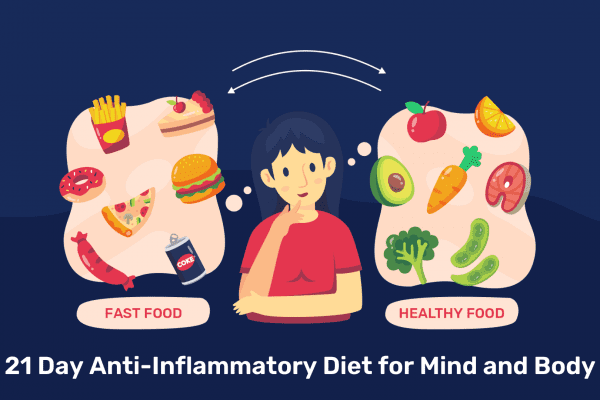Introduction
In a world where snacks are just a pantry away, especially when working from home, ‘how to stop mindless eating’ has become a question of paramount importance for many of us. Mindless eating, the habit of eating without paying attention to what or how much we’re consuming, can lead to overeating and unwanted weight gain. This blog delves into the subtle art of mindful eating, presenting 11 effective strategies that answer the crucial question: ‘How to stop mindless eating’.
From understanding your eating triggers to creating an environment conducive to mindful eating, each section will guide you on a journey towards more conscious food choices and eating habits. Whether you’re snacking out of boredom, stress, or habit, these strategies are designed to help you gain control over your eating behaviors, paving the way to a healthier, more mindful relationship with food.
1. Recognize Your Eating Triggers

A pivotal step in addressing ‘how to stop mindless eating’ involves identifying the triggers that lead to this behavior. Often, we find ourselves eating not out of hunger, but due to various other factors that prompt us to reach for food. These triggers can be emotional, such as stress, boredom, sadness, or even happiness. They can also be environmental, like seeing or smelling food, or habitual, like eating while watching TV.
Emotional Awareness:
Start by paying attention to your emotional state before and during eating. Are you truly hungry, or are you trying to fill an emotional void?
Environmental Cues:
Notice if your surroundings are prompting you to eat. Is it the sight of a candy jar on your desk, or the habit of having popcorn during a movie?
Habit Assessment:
Reflect on the times you eat mindlessly. Is it during work breaks, late at night, or when you’re with certain people?
Understanding these triggers is the first step in changing your eating patterns. Once you’re aware of why you’re reaching for food, you can begin to develop strategies to cope in healthier ways, effectively tackling the issue of ‘how to stop mindless eating’. By replacing mindless habits with mindful practices, you’ll be better equipped to make conscious food choices that align with your health and well-being goals.
2. Practice Mindful Eating

Central to solving the puzzle of ‘how to stop mindless eating’ is the practice of mindful eating. This approach involves being fully present and aware during meals, paying close attention to the experience of eating, and listening to your body’s hunger and fullness cues.
Focus on the Moment:
When eating, try to eliminate distractions. Turn off the TV, put away your phone, and concentrate on your meal. This helps in appreciating the flavors, textures, and aromas of your food.
Eat Slowly:
Take time to chew your food thoroughly. Eating slowly allows you to savor each bite and gives your body time to recognize when it is full, preventing overeating.
Recognize Hunger and Fullness:
Before grabbing a snack or second helping, ask yourself if you are truly hungry. Learn to recognize when you are comfortably full to avoid eating more than you need.
Appreciate Your Food:
Take a moment to express gratitude for your meal. This can be a simple acknowledgment of the effort that went into preparing the food or the nutritional value it provides.
Practicing mindful eating is a powerful strategy in ‘how to stop mindless eating.’ It helps create a deeper connection with your food and transforms eating from a mindless act into a nourishing and enjoyable experience. By being mindful, you can develop a healthier relationship with food and make more conscious choices about what and how much to eat.
3. Plan Your Meals and Snacks

In addressing ‘how to stop mindless eating,’ strategic planning of your meals and snacks plays a crucial role. By planning ahead, you can ensure that your food choices align with your nutritional needs and prevent impulsive eating decisions. Here’s how you can effectively plan:
Meal Prep Rituals:
Dedicate time each week to plan and prepare your meals. This not only saves time but also reduces the likelihood of reaching for unhealthy, convenient options when you’re hungry.
Balanced Meal Structure:
Plan meals that include a balance of protein, carbohydrates, and healthy fats, as well as plenty of fruits and vegetables. Balanced meals are more satisfying and help maintain steady blood sugar levels, reducing cravings.
Healthy Snack Options:
Keep healthy snacks, such as nuts, fruits, yogurt, or whole-grain crackers, readily available. This ensures that when the urge to snack strikes, you have nutritious options at hand.
Portion Control:
When planning meals and snacks, be mindful of portion sizes. Overeating can occur even with healthy foods if portions are not controlled.
Adaptability:
While consistency in meal planning is beneficial, be flexible enough to adapt to changes in your schedule or mood. The goal is to make planned eating a sustainable part of your routine.
By incorporating meal and snack planning into your strategy of ‘how to stop mindless eating,’ you take a proactive approach to your dietary habits. This helps in cultivating a mindful relationship with food and ensures that your choices support your overall health and wellness goals.
4. Keep a Food Journal

A crucial aspect of understanding ‘how to stop mindless eating’ is keeping a food journal. This simple yet effective tool can help you track your eating habits, identify patterns, and understand the triggers that lead to mindless eating. Here’s why and how maintaining a food diary can be beneficial:
Increased Awareness:
Writing down everything you eat and drink can increase your awareness of your eating habits. It makes you more conscious of what, when, and how much you’re consuming.
Identifying Triggers:
By noting the times and situations when you eat, you can identify specific triggers for mindless eating, such as emotional states, social environments, or times of day.
Pattern Recognition:
Over time, your food journal can reveal patterns in your eating behavior. You might notice that you tend to snack mindlessly in the late afternoon or when you’re feeling stressed.
Accountability:
Keeping track of your eating habits can create a sense of accountability. It encourages you to make more thoughtful food choices, knowing that you’ll be recording them later.
Planning Tool:
Your journal can serve as a planning tool, helping you make adjustments to your diet. If you notice certain nutritional gaps or too much snacking, you can plan accordingly.
To effectively use a food journal as part of your strategy for ‘how to stop mindless eating,’ be consistent and honest in your entries. The goal isn’t to judge yourself but to gain insights that can lead to healthier eating habits. Over time, this practice can significantly contribute to reducing mindless eating and fostering a more mindful approach to nutrition.
5. Control Portion Sizes

Managing portion sizes is an integral part of the strategy for ‘how to stop mindless eating.’ Controlling how much you eat can be as important as choosing what to eat. Here are some practical ways to manage portion sizes:
Use Smaller Plates:
A study by the Cornell Food and Brand Lab found that people tend to serve about 22% more pasta on a twelve-inch plate than on a ten-inch plate. Using smaller plates can create the visual effect of a full plate with less food, helping you eat less without feeling deprived.
Measure Servings:
Initially, use measuring cups or a kitchen scale to get a sense of correct serving sizes. Over time, you’ll be able to eyeball portions more accurately.
Check Food Labels:
Pay attention to the serving sizes on food labels. It can be surprising to discover how small a standard serving size is compared to what we’re used to eating.
Serve Yourself Mindfully:
Avoid eating straight from the package. Instead, serve the amount you intend to eat on a plate or bowl. This prevents unintentional overeating.
Listen to Your Body:
Tune in to your body’s hunger and fullness cues. Eat slowly and give your body time to signal when it has had enough, rather than eating until the plate is empty.
Avoid Buffet-Style Eating:
In family settings, serve food on plates rather than putting serving dishes on the table to resist the temptation to have seconds.
By controlling portion sizes, as part of ‘how to stop mindless eating,’ you can enjoy a variety of foods while maintaining a balanced diet. This approach can significantly aid in weight management and reduce the likelihood of overeating.
6. Eat Without Distractions

An essential component of ‘how to stop mindless eating’ is to eat without distractions. In today’s fast-paced world, it’s common to eat while watching TV, scrolling through smartphones, or working at a computer. However, these distractions can lead to overeating and a disconnection from the eating experience. Here’s why eating without distractions is important:
Enhanced Mindfulness:
Eating without distractions allows you to focus on your meal, leading to more mindful eating. You’re more likely to notice flavors, textures, and your body’s hunger and fullness signals.
Reduced Overeating:
When you’re distracted, you may not recognize when you’re full, leading to overeating. By removing distractions, you can listen to your body’s cues and stop eating when you’re comfortably full.
Improved Digestion:
Paying attention to your meal can also aid in digestion. Eating slowly and chewing thoroughly gives your digestive system the time it needs to process food effectively.
Quality Time with Food:
Eating should be an enjoyable and sensory experience. Removing distractions allows you to appreciate and savor your food, turning meals into a more pleasurable activity.
Creating a Calm Eating Environment:
By setting aside specific times and places for eating without distractions, you create a calm and relaxing environment that can improve your overall relationship with food.
To incorporate this practice into your routine, start by designating one meal a day as distraction-free. Gradually, try to increase this to all meals. Remember, ‘how to stop mindless eating’ is about making intentional choices around food, and eating without distractions is a significant step in that direction.
7. Listen to Your Body

A key element in ‘how to stop mindless eating’ is learning to listen to your body’s natural hunger and fullness cues and responding appropriately. Many of us have lost touch with these signals due to constant dieting, busy lifestyles, or habitual eating. Here’s how you can reconnect with your body’s cues:
Understand Hunger Signals:
Recognize the physical signs of hunger, which can include stomach growling, low energy, or irritability. Eating should be a response to physical hunger, not emotional needs or simply because it’s a scheduled mealtime.
Distinguish Between Hunger and Cravings:
Cravings are often driven by emotional factors or specific taste desires and are usually for certain types of foods, like sweets or salty snacks. True hunger, on the other hand, is more general and can be satisfied with various foods.
Rate Your Hunger:
Before eating, rate your hunger on a scale from 1 (not hungry) to 10 (extremely hungry). This can help you decide whether you need to eat now or can wait a little longer.
Mindful Eating:
As you eat, check in with yourself periodically to assess your level of fullness. Stop eating when you feel comfortably satisfied, not when you’re overly full.
Slow Down Your Eating:
It takes time for your brain to receive signals of fullness from your stomach. By eating slowly, you give yourself a chance to recognize these signals before you’ve eaten too much.
Address Emotional Eating:
If you find yourself eating when not physically hungry, explore other ways to address your emotions, like talking with a friend, taking a walk, or engaging in a hobby.
Listening to and understanding your body’s hunger and fullness cues is a crucial practice in ‘how to stop mindless eating.’ It enables you to eat in a way that satisfies your physical needs without overindulging, leading to a healthier and more balanced relationship with food.
Also Read: Healthy Food Swaps
8. Ensure Balanced Nutrition

A fundamental aspect of ‘how to stop mindless eating’ involves ensuring that your diet is balanced and nutritionally complete. A balanced diet provides your body with the necessary nutrients to function properly, helps regulate your energy levels, and can prevent cravings that lead to mindless eating. Here’s why balanced nutrition is crucial:
Variety of Nutrients:
A balanced diet includes a variety of foods from all food groups, ensuring you get a wide range of essential nutrients. This includes adequate protein, healthy fats, complex carbohydrates, vitamins, and minerals.
Regulate Blood Sugar:
Consuming a mix of protein, fiber, and healthy fats in your meals helps regulate blood sugar levels. This prevents the spikes and dips that can lead to hunger cravings and overeating.
Feel Fuller for Longer:
Foods high in fiber and protein tend to be more satiating, keeping you feeling full for a longer period and reducing the tendency to snack mindlessly.
Reduce Cravings:
Nutritional deficiencies can sometimes manifest as cravings. By eating a well-rounded diet, you can minimize cravings that often lead to unhealthy snacking.
Incorporating balanced nutrition into your strategy for ‘how to stop mindless eating’ not only aids in maintaining your physical health but also supports your mental well-being. It equips you with the energy and focus needed for daily tasks, including making mindful choices about your food intake.
9. Manage Stress and Emotions

In the journey to uncover ‘how to stop mindless eating,’ managing stress and emotions plays a pivotal role. Emotional eating, or the tendency to eat in response to stress or negative emotions rather than hunger, is a common driver of mindless eating. Here are some strategies to help manage emotional eating:
Identify Emotional Triggers:
Start by recognizing the emotions that prompt you to eat mindlessly. It could be stress, anxiety, sadness, or even boredom. Awareness is the first step in changing your response to these emotions.
Develop Healthy Coping Mechanisms:
Instead of turning to food, find alternative activities to cope with your emotions. This could include going for a walk, practicing deep breathing exercises, meditating, journaling, or engaging in a hobby.
Mindfulness Practices:
Techniques such as mindfulness meditation can help you stay present and more aware of your emotional states, enabling you to make more conscious choices about eating.
Create a Support System:
Sometimes, talking to someone can help in managing emotional distress. Consider sharing your feelings with friends, family, or a support group.
Physical Activity:
Regular exercise can be a great stress reliever. It releases endorphins, which have natural stress-fighting properties.
Adequate Rest:
Ensure you’re getting enough sleep. Lack of sleep can exacerbate stress and lead to imbalanced eating behaviors.
Professional Help:
If emotional eating is a significant challenge, seeking help from a therapist or counselor can provide you with strategies to manage your emotions in healthier ways.
By learning to effectively manage stress and emotions, you take a crucial step in resolving ‘how to stop mindless eating.’ It’s about replacing the temporary comfort of food with more sustainable, healthy habits that address the root cause of your emotions.
10. Avoid Unhealthy Snacking Habits

A significant strategy in ‘how to stop mindless eating’ is to transform your snacking habits. Unhealthy snacking can contribute significantly to mindless eating, often leading to excess calorie consumption without real nutritional benefits. Here’s how to make healthier snacking choices:
Stock Up on Healthy Options:
Keep a variety of healthy snacks readily available. Options like fruits, nuts, yogurt, whole-grain crackers, or vegetable sticks are nutritious and can satisfy your hunger without the excessive calories of processed snacks.
Portion Control:
Instead of eating directly from a large bag or box, portion out a serving size into a bowl or plate. This helps in controlling how much you eat and prevents overindulgence.
Understand Snack Labels:
Be mindful of the nutritional content of packaged snacks. Look for snacks low in added sugars and unhealthy fats but high in fiber and protein.
Plan Your Snacks:
Just as with meals, planning your snacks can help avoid impulsive decisions. Schedule your snack times and stick to them to maintain a routine.
Healthy Alternatives:
If you crave something specific like sweets or chips, look for healthier alternatives that satisfy the craving without the unhealthy aspects. For instance, choose dark chocolate over milk chocolate or air-popped popcorn instead of chips.
By replacing unhealthy snacks with healthier options and being mindful about your snacking habits, you can effectively contribute to ‘how to stop mindless eating.’ It’s about making conscious choices that align with your health goals and understanding that snacks, when chosen wisely, can be a healthy part of your diet.
11. Stay Hydrated to Stop Mindless Eating

An often-overlooked aspect of ‘how to stop mindless eating’ is staying adequately hydrated. Hydration plays a crucial role in regulating hunger and satiety, and sometimes, what we perceive as hunger is actually just thirst. Here’s how proper hydration can help in managing your eating habits:
Understand the Connection:
Recognize that dehydration can often mask itself as hunger. Before reaching for a snack, ask yourself if you might just be thirsty.
Regular Water Intake:
Make a habit of drinking water throughout the day. Keeping a water bottle nearby as a visual reminder can be helpful.
Start with Water:
When you feel the urge to snack, begin by drinking a glass of water. Wait for a few minutes to see if the hunger cues persist. This can help you differentiate between true hunger and dehydration.
Hydrate Before Meals:
Drinking water before meals can contribute to a feeling of fullness and help prevent overeating.
Track Your Hydration:
Just like a food journal, consider tracking your water intake to ensure you’re meeting your daily hydration needs.
Flavor Your Water:
If you find plain water unappealing, try infusing it with fruits, cucumbers, or herbs to make it more enjoyable and to encourage regular consumption.
Other Hydrating Beverages:
Incorporate other hydrating fluids into your day, such as herbal teas or infused water, but be mindful of the sugar content in various beverages.
Incorporating adequate hydration into your daily routine is a simple yet effective step in ‘how to stop mindless eating.’ It helps ensure that your body is adequately hydrated and aids in making more mindful decisions about when and how much to eat.
Read Further: 30-Day Water Challenge
Conclusion
In our exploration of ‘how to stop mindless eating,’ we’ve uncovered a variety of strategies that can make a significant difference in your eating habits. From recognizing your eating triggers and practicing mindful eating to planning your meals, controlling portion sizes, and ensuring balanced nutrition, each strategy plays a vital role in fostering a more mindful relationship with food. The importance of staying hydrated, managing stress and emotions, and replacing unhealthy snacking habits with healthier options cannot be overstated in this journey towards mindful eating.
The path to stopping mindless eating lies in consistent practice and mindfulness. It’s about making conscious food choices, understanding the cues your body gives you, and appreciating the role food plays in your health and well-being. Remember, change doesn’t happen overnight, but with dedication and the right approach, achieving a balanced and mindful eating habit is definitely within reach.
To support you in this journey, tools like Woliba offer invaluable resources. With features like wellness challenges, Woliba can help you and your colleagues create healthier lifestyle habits. These challenges can be a fun and engaging way to put into practice the strategies we’ve discussed, making the process of stopping mindless eating not just achievable but also enjoyable. Embracing these tools and resources as part of your daily routine can be a game-changer in your quest for a healthier, more mindful life.
Transform your lifestyle with a healthier, nutrition-based approach! Contact us today to begin your journey towards wellness.




